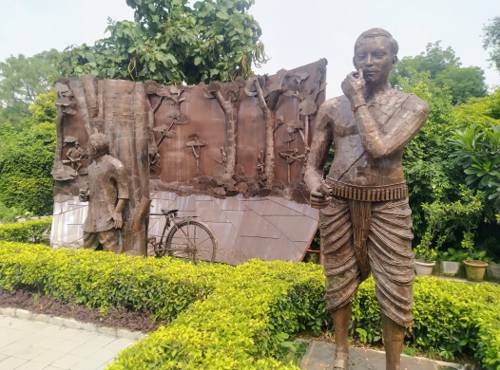
FAQ About Chandrashekhar Azad

Who was Chandrashekhar Azad?
Chandrashekhar Azad was an important figure in the Indian independence movement. Born on July 23, 1906, in Bhavra, India, he became a revolutionary leader known for his unwavering dedication to freeing India from British colonial rule. He was associated with the Hindustan Socialist Republican Association (HSRA) and was involved in several radical activities aimed at overthrowing the British government in India.

What were Chandrashekhar Azad's contributions to India's freedom movement?
Chandrashekhar Azad significantly contributed to the Indian freedom movement through his involvement with the Hindustan Socialist Republican Association (HSRA). He participated in the Kakori Conspiracy in 1925, a train robbery intended to fund the activities of the association by seizing government funds. Azad also planned and executed protests and was actively involved in organizing revolutionary activities to inspire youths to join the freedom struggle.

How did Chandrashekhar Azad get his name?
Chandrashekhar Azad took on the name 'Azad' after an incident where he was arrested as a teenager during a protest. He stood before the judge, who asked him his name, and he declared 'Azad', meaning 'free'. From then on, he vowed that the British would never capture him alive. His resolve became a symbol of defiance against colonial rule.

What was the Kakori Conspiracy?
The Kakori Conspiracy was a pivotal event in the Indian independence movement where members of the Hindustan Socialist Republican Association, including Chandrashekhar Azad, robbed a train near Kakori, Uttar Pradesh, in August 1925. The objective was to acquire funds by seizing government money to support their revolutionary activities against British rule. This act of defiance brought significant attention to the revolutionary cause.

How did Chandrashekhar Azad die?
Chandrashekhar Azad died on February 27, 1931, in Alfred Park, Allahabad (now Prayagraj). He was surrounded by police forces after an informer tipped off his location. In a standoff, rather than surrendering, Azad fought valiantly and eventually shot himself, living up to his vow that he would never be captured alive by the British.

What was Chandrashekhar Azad's role in the Hindustan Socialist Republican Association?
Chandrashekhar Azad was a key leader in the Hindustan Socialist Republican Association (HSRA). He played a vital role in planning and executing revolutionary activities aimed at dismantling British authority in India. Azad’s leadership was instrumental in organizing protests and violent resistance, which inspired many young Indians to join the freedom struggle. His commitment to socialism and independence made him a central figure in HSRA.

What impact did Chandrashekhar Azad have on the Indian independence movement?
Chandrashekhar Azad's impact on the Indian independence movement was profound. As a symbol of resistance and courage, he inspired thousands to join the fight against colonial oppression. His activities with the HSRA and personal sacrifices set a standard of extreme dedication to the national cause. Azad's life and martyrdom motivated further revolutionary efforts and inflamed the collective consciousness of a nation yearning for freedom.

Was Chandrashekhar Azad involved in any other revolutionary activities besides the Kakori Conspiracy?
Yes, Chandrashekhar Azad was involved in various revolutionary activities beyond the Kakori Conspiracy. He led efforts in the attempt to eliminate British officials, disrupted administration through protests and violence, and contributed to planning various acts of defiance against the British authorities. His entire life after joining the movement was devoted to the cause of India's freedom.

What was Chandrashekhar Azad's early life like?
Chandrashekhar Azad was born on July 23, 1906, in Bhavra, a small village in present-day Madhya Pradesh. He was the son of Pandit Sitaram Tiwari and Jagrani Devi. As a child, he was inspired by the Jallianwala Bagh massacre and joined the freedom movement early, participating in non-cooperation while still in school. His early life was marked by his rebellious nature and sense of justice, which led him to become a prominent revolutionary.

What were Chandrashekhar Azad's beliefs?
Chandrashekhar Azad believed in achieving independence for India through armed struggle and revolutionary methods. He was influenced by socialist ideals and believed in an India free from not just colonial rule but also social injustices. Azad was committed to equality and opposed any form of oppression, whether by foreign powers or within Indian society.

Did Chandrashekhar Azad have any aliases?
Yes, Chandrashekhar Azad was known by the alias "Azad," which he adopted to signify his commitment to remaining "free" and unconquered by British authorities. This name became synonymous with his role as a revolutionary and reflected his defiant spirit.

How is Chandrashekhar Azad remembered today?
Chandrashekhar Azad is remembered as a hero and martyr in the struggle for India's independence. His life and sacrifices are celebrated in Indian history as an exemplar of bravery and patriotism. Numerous schools, parks, and streets across India are named in his honor, and his story continues to inspire future generations to value and fight for freedom and justice.

What is the significance of Alfred Park in relation to Chandrashekhar Azad?
Alfred Park, located in Allahabad (now Prayagraj), holds historical significance as the place where Chandrashekhar Azad was martyred. It was here that Azad engaged in his final standoff with the British police, choosing to end his life rather than be captured. Today, the park has been renamed Chandrashekhar Azad Park in his memory and serves as a symbol of his bravery and sacrifice.

Did Chandrashekhar Azad write any notable works or speeches?
Chandrashekhar Azad was primarily focused on action rather than words and did not leave behind any written works or notable speeches. His legacy is defined through his revolutionary activities and the impact of his steadfast resolve to achieve freedom. Azad's life itself is often cited as a powerful narrative of commitment and sacrifice.

What motivated Chandrashekhar Azad to join the freedom movement?
Chandrashekhar Azad was motivated to join the freedom movement by a deep sense of injustice and patriotism, spurred by events like the Jallianwala Bagh massacre. These incidents ignited his anger against colonial oppression and inspired him to fight for India's independence. His rebellious spirit and passionate belief in freedom and equality drove him to take up arms against the British rule.

What organizations was Chandrashekhar Azad associated with?
Chandrashekhar Azad was primarily associated with the Hindustan Socialist Republican Association (HSRA), where he played a leading role in planning and executing acts of resistance against the British. This organization focused on revolutionary activities with the goal of achieving full independence for India through direct action and armed resistance.

How did Chandrashekhar Azad inspire other freedom fighters?
Chandrashekhar Azad inspired other freedom fighters through his unwavering commitment, courage, and willingness to sacrifice his life for India's independence. His principle of remaining 'Azad' (free) and never being captured by British authorities became a powerful symbol of resistive defiance. Young revolutionaries admired his dedication and were motivated to join the struggle for independence, following in his footsteps.

What legacy did Chandrashekhar Azad leave behind?
Chandrashekhar Azad left behind a legacy of courage, sacrifice, and unwavering dedication to the cause of Indian independence. His life continues to be emblematic of the revolutionary spirit that propelled India's freedom movement. His selflessness and commitment to the cause of justice have immortalized him in Indian history as a significant figure who inspired many and helped shape the course towards independence.

Was Chandrashekhar Azad involved with Bhagat Singh?
Yes, Chandrashekhar Azad was closely associated with Bhagat Singh, another prominent revolutionary leader. Together, they worked within the Hindustan Socialist Republican Association (HSRA), planning and executing various acts of revolutionary defiance against British colonial rule. Their partnership was crucial in galvanizing the youth and coordinating actions that sought to challenge and dismantle the colonial establishment.

Did Chandrashekhar Azad have any beliefs regarding non-violence?
Chandrashekhar Azad believed in the necessity of armed struggle to achieve India's independence and therefore did not conform to the non-violent methods later popularized by Mahatma Gandhi. Azad's approach was rooted in the conviction that forceful actions were necessary to overthrow British rule, although he respected the broader independence movement and shared its ultimate goal of a free India.
